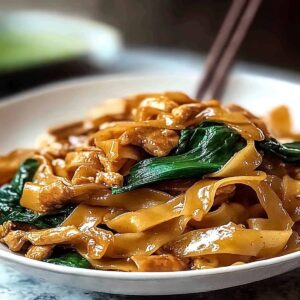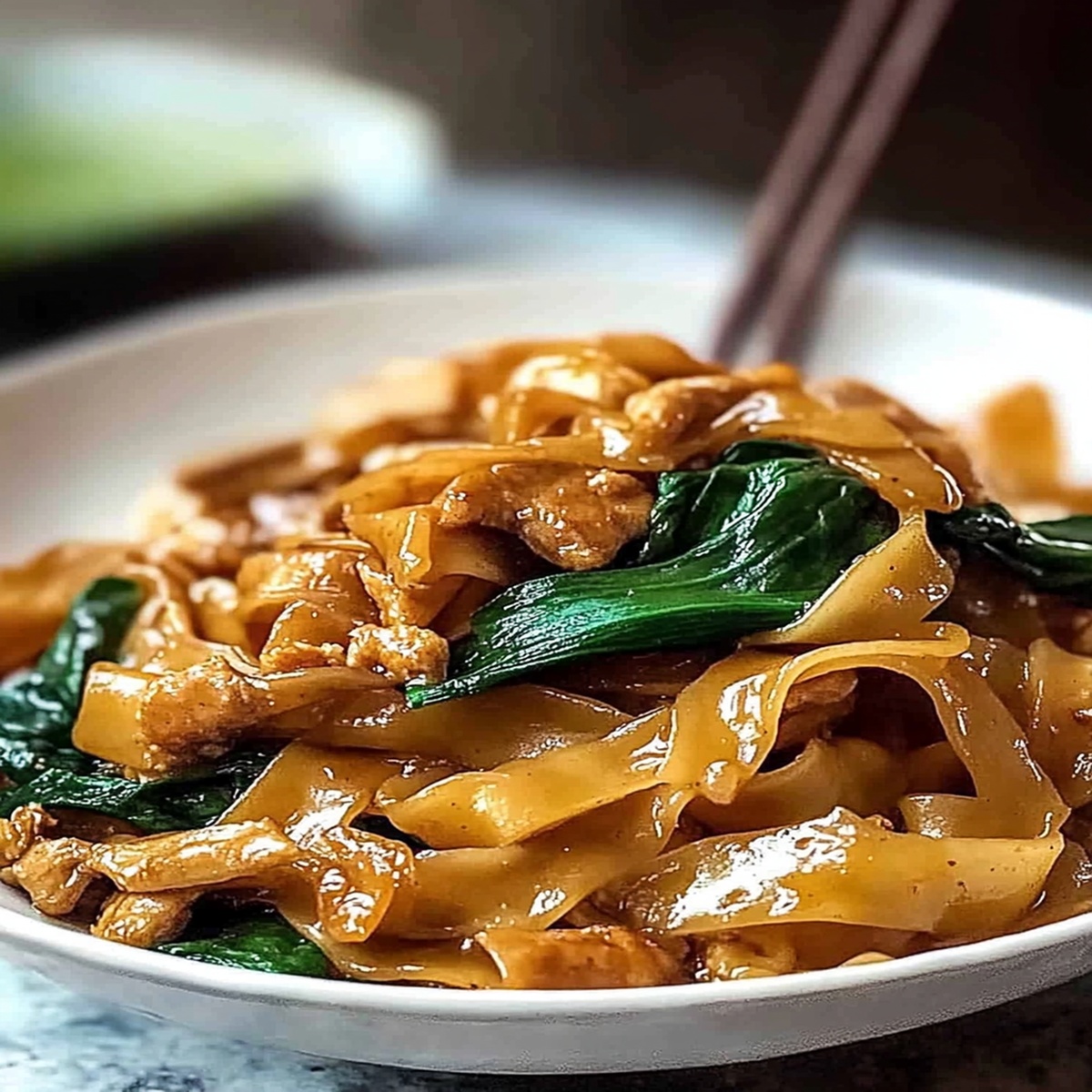The Authentic Pad See Ew: A Homestyle Thai Noodle Recipe
My recent trip to Bangkok sparked a deep love for pad see ew, a comforting street food that blends silky rice noodles with savory sauces.
Wandering through bustling markets, I watched skilled chefs toss ingredients with lightning speed in sizzling woks.
Tender chicken, crisp vegetables, and rich dark soy create a harmonious dance of flavors that feels like a warm culinary embrace.
Authentic Thai cooking might seem intimidating, but this recipe breaks down each step into simple, approachable moves.
Learning to balance sweet, salty, and umami notes becomes an adventure in your kitchen.
Mastering this classic dish connects you to generations of Thai home cooks who have perfected these techniques.
You will fall in love with how quickly this meal comes together, promising a delicious journey into southeast asian cuisine.
Ingredients for Delicious Pad See Ew at Home
Main Protein:Noodles:Vegetables:Sauce Ingredients:Cooking Ingredients:Garnish:Quick Steps to Thai Stir-Fried Pad See Ew
Step 1: Prep Noodle Base
Grab wide rice noodles and cook them in boiling water following package directions.
Ensure they’re perfectly al dente with a slight bite.
Drain thoroughly and set aside, allowing them to rest while you prepare other ingredients.
Step 2: Create Flavor-Packed Sauce
Combine in a small bowl:Whisk ingredients until sugar dissolves completely, creating a rich, glossy sauce that will coat the noodles beautifully.
Step 3: Sizzle Protein
Heat oil in a large wok or skillet over medium-high heat.
Add chicken or tofu, cooking until golden brown and fully cooked through.
The protein should develop a crispy exterior while staying tender inside.
Step 4: Add Colorful Vegetables
Toss into the pan:Stir-fry the vegetables for about three minutes.
They should remain vibrant and crisp, maintaining their nutritional value and adding delightful texture to the dish.
Step 5: Bring Everything Together
Drop the cooked noodles into the wok.
Pour the prepared sauce over the ingredients.
Gently toss everything, ensuring each noodle gets coated with the savory sauce.
The goal is to create a harmonious blend of flavors and textures.
Step 6: Serve and Garnish
Transfer the steaming Pad See Ew to serving plates.
Sprinkle chopped green onions on top for a fresh, zesty finish.
Serve immediately while hot and enjoy the authentic Thai street food experience right at home.
Helpful Tips for Pad See Ew Perfection
How to Store and Reheat Thai Noodles Like a Pro
What Goes Best with Pad See Ew for a Full Meal
Pad See Ew: Ways to Mix Up the Flavors
FAQs
The key ingredients include wide rice noodles, soy sauces (low-sodium and dark), chicken or tofu, broccoli, carrots, and brown sugar to create the classic Thai stir-fry flavor profile.
No, Pad See Ew is not typically spicy. It’s a savory, slightly sweet noodle dish with a rich umami flavor from the soy sauce combination.
Absolutely! Simply replace the chicken with tofu or add more vegetables like mushrooms or bell peppers to create a delicious vegetarian version of the dish.
Dark soy sauce adds deeper color and richer flavor, while light soy sauce provides saltiness. The combination creates the signature taste and appearance of authentic Pad See Ew.
Why You’ll Love Pad See Ew Thai Stir-Fried Noodles
Print
Pad See Ew (Thai Stir-Fried Noodles) Recipe
- Total Time: 25 minutes
- Yield: 2 1x
Description
Sizzling Pad See Ew brings Bangkok street flavors straight to your kitchen with wide rice noodles dancing in a savory sauce. Fragrant wok-charred edges and tender chicken create an irresistible Thai classic you’ll crave again and again.
Ingredients
Main Proteins:
- 1 cup thinly sliced chicken breast or tofu (240 grams)
Vegetables:
- 1 cup broccoli florets (150 grams)
- 1 cup julienned carrots (150 grams)
Noodles and Seasonings:
- 8 ounces (226 grams) wide rice noodles
- 3 tablespoons low-sodium soy sauce
- 2 tablespoons dark soy sauce
- 1 tablespoon brown sugar
- 2 tablespoons cooking oil (for sauteing)
Instructions
- Prepare wide rice noodles according to package directions, ensuring they reach al dente texture. Carefully drain and reserve for later use.
- Create a harmonious sauce by whisking low-sodium soy sauce, dark soy sauce, and brown sugar in a small mixing vessel until thoroughly integrated.
- Warm a large wok or skillet over medium-high heat, introducing cooking oil to create a sizzling surface.
- Introduce chicken or tofu, searing until achieving a golden-brown exterior and ensuring complete internal cooking.
- Toss broccoli florets and julienned carrots into the pan, stir-frying for approximately 3 minutes to maintain vibrant color and crisp-tender consistency.
- Gently fold the prepared rice noodles into the vegetable and protein mixture, carefully coating with the previously prepared sauce.
- Continue stirring and tossing ingredients for an additional 1-2 minutes to allow flavors to meld and noodles to absorb the sauce completely.
- Transfer the aromatic pad see ew to serving plates, garnishing with finely chopped green onions for a fresh, herbaceous finish.
Notes
- Noodle Perfection: Choose fresh wide rice noodles for the most authentic texture, avoiding dry or brittle noodles that might break during stir-frying.
- Quick Stir-Fry Technique: Ensure your wok or skillet is screaming hot before adding ingredients to achieve that signature wok hei caramelized flavor and prevent soggy noodles.
- Protein Flexibility: Swap chicken for tofu, tempeh, or shrimp to accommodate different dietary preferences and create delicious variations of this classic Thai dish.
- Gluten-Free Adaptation: Replace traditional soy sauce with tamari or coconut aminos to make the recipe completely gluten-free without sacrificing rich umami flavor.
- Prep Time: 10 minutes
- Cook Time: 15 minutes
- Category: Lunch, Dinner
- Method: Sautéing
- Cuisine: Thai
Nutrition
- Serving Size: 2
- Calories: 460
- Sugar: 4 g
- Sodium: 850 mg
- Fat: 18 g
- Saturated Fat: 2 g
- Unsaturated Fat: 14 g
- Trans Fat: 0 g
- Carbohydrates: 61 g
- Fiber: 3 g
- Protein: 24 g
- Cholesterol: 70 mg


Jack Sullivan
Founder & Culinary Storyteller
Expertise
Single-recipe development with a narrative approach, Culinary storytelling and food history, Seasonal and regional ingredient utilization, Home cooking techniques adapted for modern kitchens
Education
New England Culinary Institute (Montpelier, VT)
Certificate in Culinary Arts
Focused on farm-to-table cooking, sustainable practices, and modern plating techniques.
Asheville-Buncombe Technical Community College
Associate Degree in Culinary Arts
Emphasized Southern Appalachian cuisine and local ingredient sourcing.
Jack grew up surrounded by smoky skillets and handwritten recipes in the mountains of North Carolina. His roots in Appalachian cooking shaped the way he sees food – as something that connects people, tells a story, and holds meaning.
With hands-on training and a background in sustainable, regional cooking, Jack started Boil And Broil to make meaningful meals more accessible. He’s all about one-dish recipes that are simple to follow but rich with flavor and history.